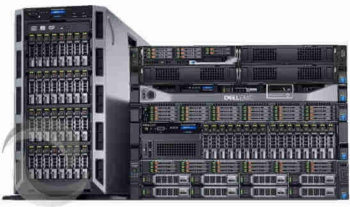Dell EMC Aims High by blending HCI products with PowerEdge 14th Gen. Servers
Dell EMC has come a long way since releasing their HCI product line four years ago. The hyper-converged infrastructure products (HCI) are the fastest growing in the technology industry, according to the International Data Corporation (IDC).
HCI products are becoming widely adopted by various organizations all over the world. Currently the global market is predicted to be around $4 billion and will escalate to $7.6 billion by 2021.
For those who are not familiar with what HCI is, let’s take a quick look.
What is HCI?
HCI is an infrastructure which integrates storage, server, computing, virtualization, and network capabilities in a single appliance. It is an approach to leverage the storage and computing activities in a single entity. HCI uses a software centric architecture to control the hardware commodity and is offered by a single provider.
Instead of utilizing storage and computing as different aspects, HCI ‘s wide range of storage and processors result in a deployment which is greater than the overall sum of the parts. HCI containerised computing and storage activities through industry approved APIs and customized management software. It can be considered a software defined storage (SDS) which renders management and automation capabilities to run computing tasks alongside each other.
The whole system is easy to manage and cut costs for the organization. Many industries like banking, education, healthcare, telecommunication, agriculture, manufacturing, oil and gas, and even governmental organizations are investing heavily in HCI. Companies big or small on their way to digital transformation find HCI the right package which combines all the important aspects.
In the second quarter of 2017, the global HCI market recorded a growth of 48.5% in year over year revenue, revealed IDC. Out of all converged infrastructure sold globally, 25% is occupied by HCI.
According to IDC’s enterprise storage and converged system’s research director Eric Sheppard, the demand for HCI is really thriving and increasing. They are easy to deploy, manage, and scale. They are proven systems that combine the most useful IT technologies and act as key players in growth and expansion.
Dell EMC plays a vital role in the market with a leading position globally. It accounts for nearly 29% of the HCI market all over the world.
EMC is Upping its HCI Lineup
The Dell EMC VxRail and XC Series have been really popular in the market, and are going to have much better performance and reliability from now on. Both the infrastructure will run on the PowerEdge 14th generation server platform, Dell recently announced. The company has introduced the new lineup in Thailand and is looking forward to penetrating further industries and markets. Dell also wants to invest heavily so that the technology becomes familiar and is adopted increasingly across the industries.
The EMC VxRail Series has been developed in collaboration with VMware and is driven by VMware vSAN. The XC lineup comes with a wide array of options of hypervisors like multi-hypervisor environments or the Microsoft Hyper-V.
The PowerEdge servers are designed by Dell to optimize the performance of its HCI portfolio. With greater configuration capability, the platform is able to carry out multiple mission-critical software tools on the XC and VxRail Series.
The PowerEdge 14th generation servers are powered by the Intel Xeon processor with 150 built-in custom requirements for storage. SSDs in scale-out deployments have received improved support while initializations become faster and data storage management is streamlined. The drive cooling is also more efficient in the PowerEdge platform.
The improvements will be responsible for 1.7 times more processing capability and will give quick access to data and applications with 62% increased internal bandwidth. The appliances will also have faster memory and higher memory channels.
The robust and predictable performance have become a need as the EMC HCI products are making their way to core data centers. Enterprises will benefit from the ability to run a vast range of workloads and application on the platform, which will help the organizations handle increasing business demands.
The Dell EMC PowerEdge 14th generation servers running EMC VxRail applications are now available and can be ordered. The XC series lineup that comes with the PowerEdge platform includes the XC740, XC740xd and XC640.
Improved Performance and Reliability
The constant innovation and engineering of EMC has made it the market leader in HCI products. It now controls almost half of the global HCI market. This new server will leverage the performance of the XC and VxRail appliance many times and make them even more effective.
Computing-intensive workloads of the EMC XC series running on PowerEdge platform can work optimally with each appliance gaining access to 50% more cores. Workloads that depend on storage density will encounter 93% increased computing capability. VDI environments will also be enriched with additional use cases.
The EMC VxRail series can now tackle most of the demanding applications thanks to 2x increased IOPS and 2x faster responses. Not only that, the response times also have become 9 times more predictable. Additionally, it is easy to identify the accurate size deployment as the platform allows endless configuring options. Companies will be able to scale effortlessly and the integration of technologies leads to better results.
Dell EMC Converged Platforms and Solutions Division’s president Chad Sakac said that organizations are turning to HIC as a platform to simplify their IT activities which will be a need in the future. Being a software-defined infrastructure, HCI can offer superior performance and reliability by ideally integrating software with the optimal hardware and its configurations. EMC has come up with pre-integrated, tested and proven HCI infrastructure that enables organizations to simply scale their IT system supported by powerful performance and dependability.
The HCI products offered by EMC now constitute 25% of the converged platform business. It is a heavily invested sector as more industries adopt the technology because of its overall lower downtime, increased speed, cost reduction, and lower requirement of human interventions.





